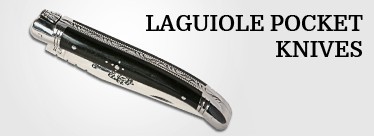- History
- Technical Questions
- To know a Laguiole
- Laguiole upper parts details
- The bladestop
- From steel bar to knife
- Closing systems for pocket knives
- How to sharpen your knife ?
- Sharpening stones
- Unkeep of folding knives
- Upkeep of your kitchen knife
- Cutlers adresses
- Stainless steel and carbon knife
- The art of shaving with the straight razor
- Upkeep of straight razor
- Materials
Damask steel


Damascus steel forging is a way of refining iron through a succession of hammering, folding and drawing, out operations. These steps aim to get rid of the impurities in the metal. A composite material is therefore created with a succession of more or less homogeneous layers, usually iron, steel or nickel combinationsl.
The heterogeneous texture induces rather exceptional mechanical qualities, because Damascus steel can only partially be quenched (neither iron nor nickel quench). As a result, the metal withstands breaking by diffracting shockwaves.
There are several techniques to forge Damascus steel:
1.The western or Merovingian technique.
It was used by Merovingian blacksmiths, this process, which consisted in changing the shape of the metal, inexplicably got lost towards the end of the 11th century.
2. Eastern Damascus steel or fusion Damascus steel is the epitome of Damascus steel.
Wootz is to blacksmiths what the philosopher's Stone is to alchemists,but despite continuing efforts,it seems that no one has so far been able to recreate this extremely complex crafting process.
3. Japanese Damascus is the type which is found nowadays.
It is forged by hammering and drawing out. Originally in the thousands, the layers constituing sword blades have progressively gone down to a few hundred. Indeed, any more and the texture is too dense and the acid retching no longer produces aesthetiically pleasing results.
Beyond the undeniable mechanical properties of Damascus steel blades, it is important to emphasize their beautiful aspect.
The composite quality of the material hides numerous anamorphic potentialities which depend both on the folding and drawing out, as well as the deep work (for example sculpting) of the metal.
Once the Damascus steel element has the desired shape, all that is left to do is to submerge it in acid which blackens only carbon and thus reveals the structure of the metal.
Stainless Damascus steel, nevertheless highly carbon- loaded, is made from powder steel (very fine grain, lasting edge) because the intrinsic mechanical quality of the metal allows for very hard quenching ( up to 63-4 Rockwell) following cryogenization.
Powder metallurgy
When making metal using powder metallurgy techniques, the molten ore goes into a vacuum box where it receives a splashing of argon : the droplets of gas fix the molecules and the ore turns into powder.
Depending on the desired steel quality, the various powders are then mixed, heated in an isostatic oven, in vacuum conditions and compressed under high pressure (2000 bars).
Thus manufactured, steel has practically no porosity which means it can be used in high-tech sectors such as the aerospace industry.
In cutlery powder metallurgy steels are a first class material to make carbon-loaded stainless Damascus. And during the forging with the various foldings and drawings, gorgeous and various designs can be obtained.
Our Damascus steel knives all have a stainless Damascus blade made of 120 layers.








